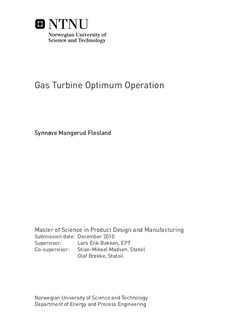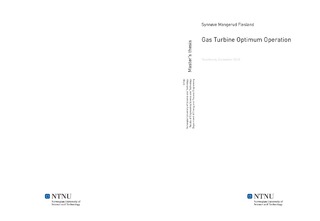| dc.contributor.advisor | Bakken, Lars Erik | nb_NO |
| dc.contributor.advisor | Madsen, Stian-Mikael | nb_NO |
| dc.contributor.advisor | Brekke, Olaf | nb_NO |
| dc.contributor.author | Flesland, Synnøve Mangerud | nb_NO |
| dc.date.accessioned | 2014-12-19T11:46:06Z | |
| dc.date.available | 2014-12-19T11:46:06Z | |
| dc.date.created | 2011-04-05 | nb_NO |
| dc.date.issued | 2010 | nb_NO |
| dc.identifier | 408465 | nb_NO |
| dc.identifier | ntnudaim:5800 | nb_NO |
| dc.identifier.uri | http://hdl.handle.net/11250/234156 | |
| dc.description.abstract | Many offshore installations are dependent on power generated by gas turbines and a critical issue is that these experience performance deterioration over time. Performance deterioration causes reduced plant efficiency and power output as well as increased environmental emissions. It is therefore of highest importance to detect and control recoverable losses in order to reduce their effect. This thesis project was therefore initiated to evaluate parameters for detecting performance deterioration in addition to document different aspects of gas turbine degradation and performance recovery. Compressor fouling is the largest contributor to performance deterioration. Investigating fouling was therefore the main focus of this study.In the present study the deterioration rates of four different gas turbines were evaluated. When choosing gas turbines it was emphasised to select gas turbines operating under equal conditions but with different washing procedures. In addition to offline washing two of the gas turbines had daily online washing routines and one of the gas turbines run idle wash every 1000 hour between each offline wash. Data was extracted from the monitoring software, TurboWatch, and loaded into Excel files. MATLAB scripts were created to handle the large amount of data and visualize performance trends. Series of two parameters were plotted against each other and the graphs were evaluated.The evaluation showed that an overall trend was that the gas turbine that had been running with online washing continuously over a long period of time had higher performance than the reference engine. For the second gas turbine a daily online washing procedure has recently started. The advantage with the evaluation of this gas turbine was that a good reference engine was available. The two engines were operating under quite similar conditions at the same location in addition to having equal filter systems. Some deterioration trends were possible to detect. For the first period both engines seemed to have quite equal deterioration trends. During the second period no clear trends were seen in corrected CDP and corrected EGT when evaluated for constant GG speed. The compressor efficiency had decreasing trends for both engines during the second period as well, but the compressor efficiency for machine 1 was overall higher during the period with online washing than the previous period. The borescope pictures taken after the first period with online washing showed good visual results. However, it is too premature to make a final decision regarding the exact performance gain of online washing. At the time the study was performed the engine had only been running online washing for one operating interval, and more investigation over longer time is recommended. For the engine running with idle wash it was not possible to conclude on the basis of the collected data. No clear deterioration trends were detected and investigations over longer time and several operating intervals are recommended. It is also important to be aware of the fact that the performance gain of idle wash needs to be much higher than for online washing in order for idle wash to be economically profitable. There are several uncertainties related to performance trends. These include inaccuracy in instrumentation, monitoring software, calibration etc. Due to the fact that all the gas turbines evaluated in this study only have standard instrumentation it caused additional uncertainty in the performance trends. One suggestion for further study is to initiate a test instrumented gas turbine into operation with sensors for measuring inlet pressure depression | nb_NO |
| dc.language | eng | nb_NO |
| dc.publisher | Institutt for energi- og prosessteknikk | nb_NO |
| dc.subject | ntnudaim:5800 | no_NO |
| dc.subject | MTPROD produktutvikling og produksjon | no_NO |
| dc.subject | Energi-, prosess- og strømningsteknikk | no_NO |
| dc.title | Gas Turbine Optimum Operation | nb_NO |
| dc.type | Master thesis | nb_NO |
| dc.source.pagenumber | 105 | nb_NO |
| dc.contributor.department | Norges teknisk-naturvitenskapelige universitet, Fakultet for ingeniørvitenskap og teknologi, Institutt for energi- og prosessteknikk | nb_NO |

